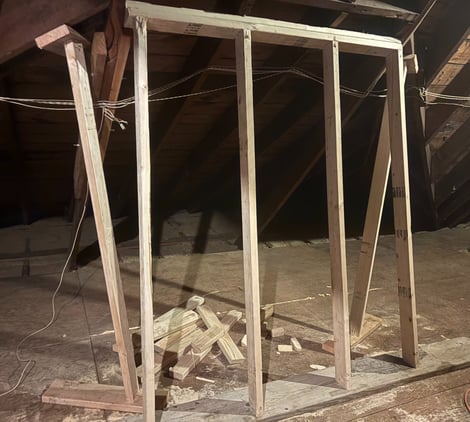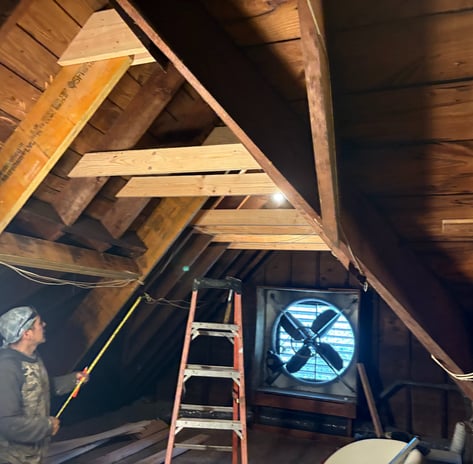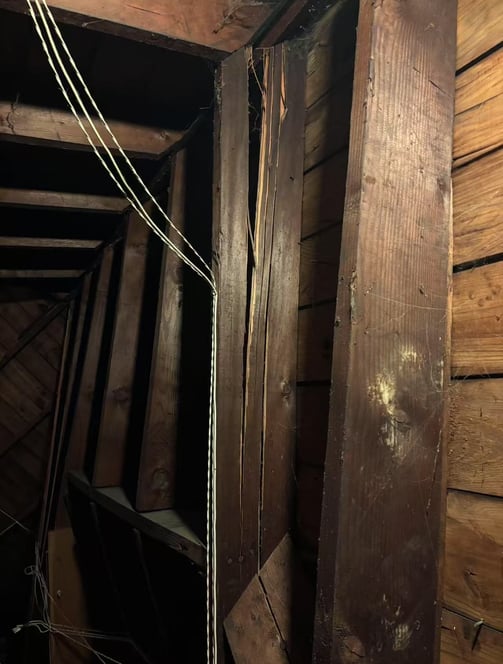Structural Repairs
Common Structural Beam Repair Methods:
The method of repair depends heavily on the type of beam (wood, concrete, steel), the extent of the damage, and the cause. Here are some common techniques:
Sistering Beams: If a beam is weakened but still partially sound, a new beam (wood or steel) is attached alongside it to provide additional support and reinforce the framing without a full replacement.
Full Beam Replacement: In cases of severe damage, particularly with dry rot or extensive decay in timber beams, the entire beam may need to be removed and replaced with a new one (wood or steel). This is a more complex and costly procedure, as temporary supports are needed to hold the structure while the beam is replaced.
Reinforcement with Steel:
Angle Iron: For localized damage in wood beams, angle iron can be cut to size and secured against the side of the beam with lag screws to compensate for the damage.
Steel Plates/Rods/Cables: Steel plates, rods, or high-tension cables can be added to concrete or timber beams to increase their load-bearing capacity and prevent further damage.
Epoxy or Polyurethane Injection: For cracks in concrete beams, high-strength epoxy resin is injected to fill the gaps and restore integrity. Polyurethane foam can also be used, expanding to fill gaps and offering flexibility.
Carbon Fiber Reinforcement (CFRP): This advanced technique is increasingly popular for strengthening concrete and sometimes timber or steel beams. Carbon fiber straps, fabrics, or laminates are bonded to the beam's surface using epoxy resin. This significantly enhances flexural (bending) and shear capacity, extends the beam's lifespan, and is often less invasive than traditional methods. It can be used for both "normal section strengthening" (improving bending capacity) and "oblique section strengthening" (improving shear capacity).
Adding Lally Columns/Support Posts: If a beam or joist is sagging, temporary or permanent lally columns (steel support posts) can be installed to lift and support the weakened area.
Increasing Section Strengthening: For concrete beams, the concrete section area and amount of steel bars can be increased to improve both bending and shear bearing capacity.




Repairing structural beams is necessary to preserve a building's stability and safety. The basic structural components that bear weights and transmit them to columns and foundations are beams. Damage to one beam has the potential to jeopardize the entire structure and cause major problems including bending, cracking, or even collapse.
Structural Beam Repair
Structural Roof Repair
Structural roof repair is critical to the overall integrity and safety of any structure. The roof structure, which includes trusses, rafters, purlins, and beams, supports the weight of the roofing material, accumulated precipitation (rain in the Philippines), and wind loads. Damage to these structural components can result in leakage, drooping, and even catastrophic collapse.
Common Structural Roof Repair Methods:
The appropriate repair method depends on the material (wood, steel, concrete), the extent of the damage, and the specific structural element affected.
Timber Truss/Rafter Repair:
Sistering: Similar to beam repair, a new piece of timber (often pressure-treated to prevent future rot) is bolted or screwed alongside a damaged rafter or truss member to provide additional support and strength.
Scabbing/Splinting: Smaller sections of timber or plywood are fastened to the sides of a damaged member to reinforce it.
Metal Plate Connectors/Gussets: For weakened joints or cracked members, steel plates (gussets) are often used on both sides of the timber and secured with bolts or screws to reinforce the connection.
Full Member Replacement: If a section of a truss or rafter is severely rotted, infested, or broken, the entire affected member may need to be carefully removed and replaced. This requires temporary shoring to support the roof during the process.
Epoxy Consolidation: For minor cracks or localized rot, epoxy resins can be injected into the timber to consolidate and strengthen the damaged area.
Steel Truss/Purlin Repair:
Welding/Plating: Cracked or corroded steel members can be repaired by welding new steel plates over the damaged sections to reinforce them. This requires specialized welding expertise.
Bolting/Reinforcement: New steel sections can be bolted to existing members to increase their load-bearing capacity.
Corrosion Treatment: Rust and corrosion must be removed, and the steel treated with rust-inhibiting primers and protective coatings.
Concrete Roof Slab/Beam Repair:
Crack Injection: For cracks in concrete roof slabs or supporting beams, epoxy or polyurethane resins are injected to seal the cracks and restore structural integrity.
Carbon Fiber Reinforcement (CFRP): Carbon fiber straps, fabrics, or laminates can be bonded to the concrete surface to significantly enhance its flexural and shear strength, especially for sagging or overloaded slabs/beams.
Concrete Patching/Repair Mortars: For spalling concrete or exposed rebar due to corrosion, the damaged concrete is removed, the rebar is cleaned and treated, and then new repair mortar is applied.
Underpinning/Shoring: If a concrete roof structure is severely compromised, temporary supports might be needed while more extensive repairs or replacements are carried out.


FairfieldRoofRepair.com
53 Balmforth Avenue Danbury
203-580-4951


Copyright 2024. All Rights Reserved. Fairfield Roof Repair
